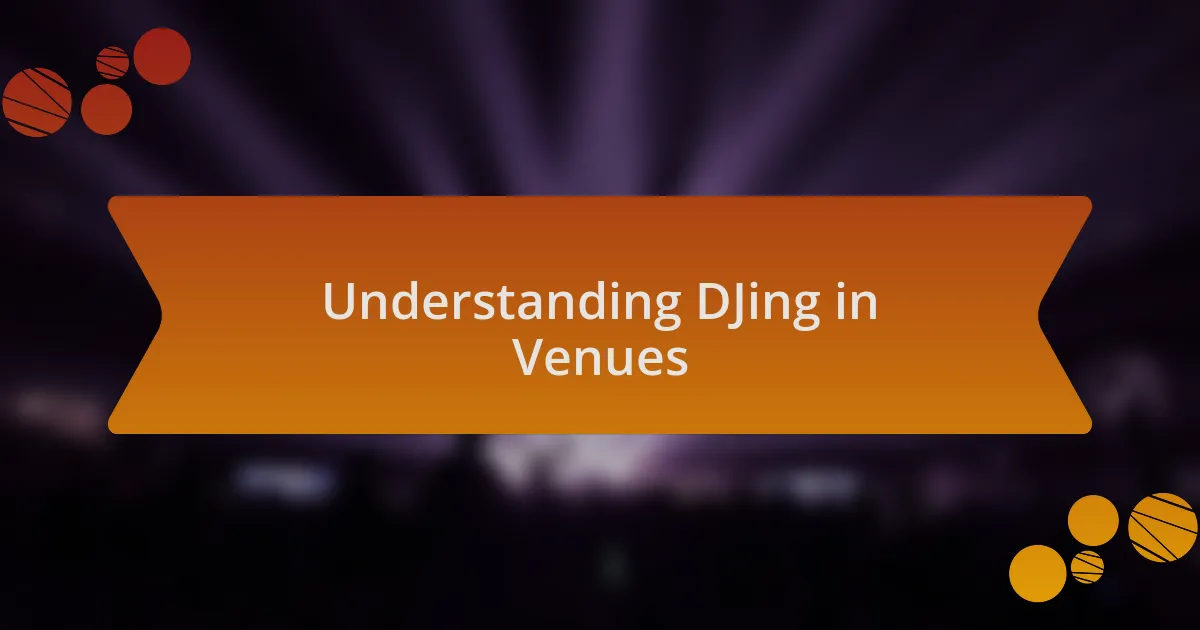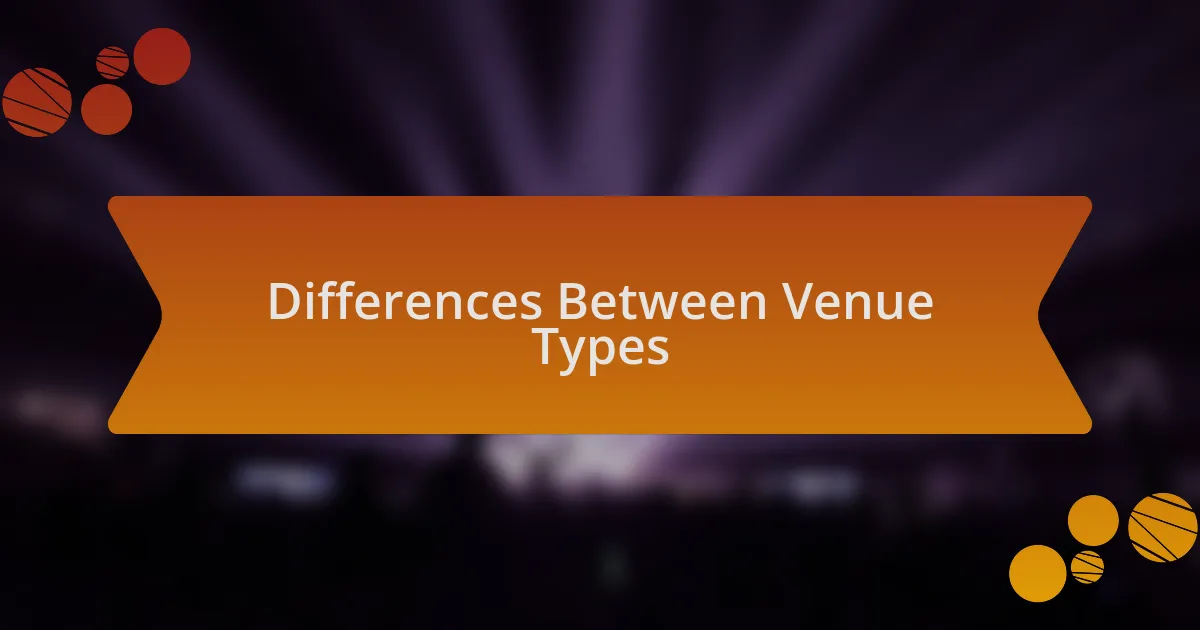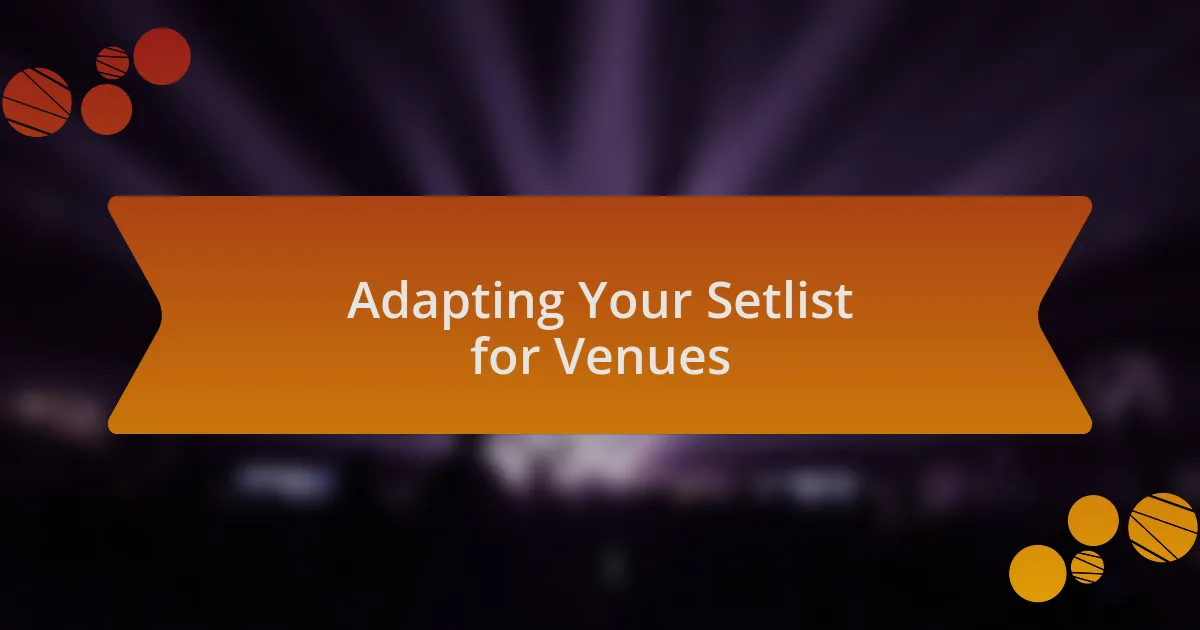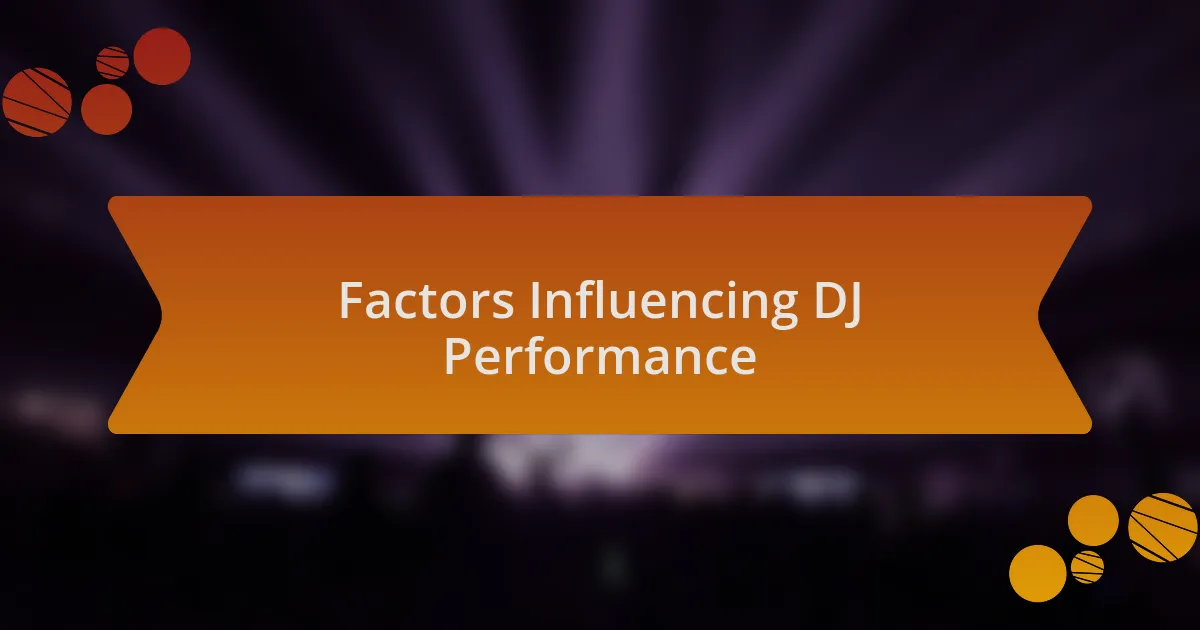Key takeaways:
- DJing in different venues requires adaptability to the space and audience, influencing the music selection and mixing style.
- Music in nightclubs creates a unifying atmosphere, energizing the crowd and facilitating self-expression.
- Understanding venue dynamics, such as acoustics and audience demographics, enhances a DJ’s performance and audience connection.
- Personal experiences highlight the emotional impact of music, demonstrating how shared moments can foster deeper connections with the audience.

Understanding DJing in Venues
Understanding DJing in different venues requires a keen awareness of both the space and the crowd. I remember my first time playing at an outdoor festival; the vastness of the space changed my approach entirely. How do you connect with thousands of people dancing under the stars? It’s all about reading the energy and adjusting the sound.
In smaller venues, the intimacy can be electrifying. I once spun at a cozy bar where I could see every reaction from the crowd, which was both exhilarating and daunting. The ability to interact with the audience on such a personal level allowed me to tailor my set in real-time. Isn’t it fascinating how the environment can shape the music and the moment?
Larger venues, such as nightclubs, often come with advanced sound systems and lighting effects that can elevate the experience. The first time I played at a club with a state-of-the-art setup, I felt a surge of creativity. But I had to adapt my mixing style to ensure each beat resonated within that expansive space. What techniques do you think work best for making an impact in such environments? Understanding the venue’s acoustics and layout becomes crucial in creating that unforgettable vibe.

Importance of Music in Nightclubs
The importance of music in nightclubs extends far beyond just background noise; it serves as the very heartbeat of the venue. I recall a night when a particular track ignited the dance floor, causing everyone to move as one. Think about it: isn’t it magical how a single song can unify a diverse crowd and create that shared experience?
Moreover, music is essential for building the atmosphere of a nightclub. I once had the chance to play a closing set that started with softer melodies, gradually ramping up the energy as the night progressed. It struck me how the right playlist can transform the vibe, keeping the energy flowing and the crowd engaged. How do you think a well-crafted musical journey affects the emotions of those on the floor?
Finally, music in nightclubs acts as a medium for self-expression. I’ve seen people let go of their inhibitions, getting lost in the rhythm. It’s fascinating how the right tune can evoke feelings of joy, nostalgia, or even freedom. Have you ever noticed how, in those magical moments, the music transcends the ordinary, making us all feel alive?

Differences Between Venue Types
When I think about the differences between venue types, it’s clear that both the physical space and audience dynamics play crucial roles. For instance, I once DJed at an intimate lounge compared to a massive festival stage, and the energy in each was undeniably different. How does a smaller audience’s closeness to the DJ alter their reactions and the overall vibe? It’s fascinating.
In larger venues, it’s often about the spectacle—the visuals, the lights, and the sheer scale can amplify the music’s impact. I remember doing a set at a sprawling arena where the crowd spread far and wide; the energy felt like a wave. However, in a cozy bar setting, every nod and smile from the audience feels deeply personal, creating an immediate connection that can be more difficult to establish on a larger stage. Have you felt that immediate atmosphere shift based on the size of the venue?
Moreover, the type of music that resonates often shifts with the venue. For example, while high-energy electronic beats might dominate a nightclub, a laid-back acoustic vibe thrives in a café setting. I recall experimenting with different genres during my sets; the response varied wildly depending on whether I was in a vibrant club or a serene rooftop bar. Isn’t it intriguing how the venue’s identity can shape what music feels appropriate or appealing?

Adapting Your Setlist for Venues
Adapting your setlist for different venues requires keen awareness of the environment and audience mood. I recall a night at a pulsating nightclub where I transitioned seamlessly between house tracks and hip-hop beats, gauging the crowd’s reaction with every drop. The dance floor felt electrified; it’s remarkable how reading the atmosphere can inspire spontaneous changes to your planned playlist. Have you noticed how the vibe of the crowd can lead you to swap tracks on the fly?
In contrast, when I DJed at a rooftop event under the stars, the music had to evoke a more chill, contemplative ambiance. I remember shifting to softer, melodic tunes that created a sense of intimacy, encouraging conversations and connections rather than wild dancing. It’s a beautiful reminder that not every venue calls for high-energy bangers; sometimes, it’s about creating a shared experience that resonates on a deeper level. Do you think the mood of the venue should dictate the tempo of your music?
Listening to the crowd is just as important as the venue itself. I once found myself in a small artsy gallery setting, where the audience yearned for something quirky and off-beat. I dipped into my collection of eclectic tracks, and the crowd’s enthusiasm was palpable—it felt like we were all on this unique journey together. This experience reinforced my belief that adapting your setlist isn’t just about the space; it’s about connecting with the audience and creating a memorable moment. Isn’t the ability to read and respond to them the true essence of what it means to be a DJ?

Factors Influencing DJ Performance
The choice of venue layout significantly impacts a DJ’s performance. For instance, I’ve played in expansive arenas where the sound has to travel across vast spaces. There, I learned to tweak my bass levels, ensuring the music reached every corner effectively. Have you ever noticed how the acoustics of a place change the music’s vibe? It’s fascinating how the right adjustments can enhance or diminish the energy on the dance floor.
Another factor is the audience’s age demographic. One memorable gig was at a college event, where the crowd was primarily in their early twenties. I remember dropping tracks from trending artists that resonated with their youthful energy, creating an unforgettable night filled with enthusiasm. It made me wonder, how well do we know the people dancing to our tunes? Understanding who’s listening allows a DJ to resonate more profoundly with the crowd.
Lastly, the technical setup plays a crucial role. I once faced a challenging setup where the mixer was subpar, but it pushed me to adapt and be creative. I used the limitations to explore new ways of blending sounds. This experience taught me that our tools can either limit us or unlock new possibilities. Isn’t it incredible how sometimes, working with what you have can lead to unexpected breakthroughs in your performance?

Personal Experiences in Nightclubs
There’s something electric about the energy in a nightclub on a packed weekend night. I recall spinning at a local hotspot where the crowd was pulsating in sync with the beats. As I mixed, I could feel the connection—the way a well-timed drop caused a wave of exhilaration. Have you ever felt that rush when a song you love drops? It’s that moment that reassures me why I love what I do.
A contrasting experience was at a small underground venue. The intimacy of the space meant I was just a few feet from the audience, and I could see their faces light up as I played a nostalgic track. It struck me how powerful that proximity can be; sharing those intimate moments turns the performance into a collective experience. Have you ever shared a special moment with someone through music? It’s a reminder of the human connection that transcends everything else.
There was also a night where technical issues threatened to derail the set. The controller malfunctioned just as I was building up to a climactic moment. Instead of panicking, I decided to engage the audience, telling them about the hiccup while improvising some acapella beats to keep the energy alive. The way they rallied around created a unique camaraderie that I still cherish. Have you ever seen adversity transform into a bonding experience in a packed room? That night taught me resilience can create unforgettable memories.